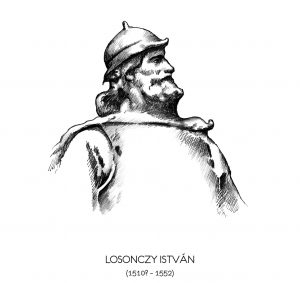 Nobleman, landlord and captain general of Temesvár (today Timişoara, Romania).
Nobleman, landlord and captain general of Temesvár (today Timişoara, Romania).
The capatin generals of Southern Hungary remained in office in their headquarters in Temesvár, even after the Battle of Mohács (1526). Until 1530 there were many captain generals on Kaiser Ferdinand I’s side, like Péter Perényi (1526-1527) and Bálint Török (1528-1530). Beginning from 1541 this office was fulfilled by Péter Petrovics as Sulieman I’s tributary.
In 1542, Losonczy together with Péter Perényi, under the command of marquis Joachim took part in besieging Pest. At first he sided János Szapolyai, so Ferdinand I levelled accusations against him several times. In 1547, after he became Lord Lieutenant of Nógrád County, he was pardoned. To show his gratitude, together with András Báthory, Tamás Nádasdy and Gian Battista Castaldo, he went to Transylvania to get it for the Habsburg Empire.
Around 1540 he married Anna Pekry, László Országh’s widow. They had two daughters: Fruzsina and Anna, poet Bálint Balassi’s later sweetheart. After his death Ferdinand I invested Losonczy’s daughters with rights that only mail heirs had been earlier entitled to. Fruzsina married Lord Chief Justice Miklós Báthory, while Anna married Kristóf Ungnád, who later became governor of Croatia.
In 1551 György Fráter unified the country, as a consequence Temesvár got under Hubsburg jurisdiction again. At this time Losonczy took over the control of the castle and its estates -that had been under Christian jurisdiction. He defeated the Turkish troops that were plundering the region several times and managed to easily beat the siege run by the Turkish governor Mohammed back. His sworn statement made on September 20, 1552 in Pozsony (today Bratislava, Slovakia) is preserved by the State Archives of Hungary in Budapest: Juramentum Stephanus de Lossonczij de officio Comitis Themesiensis et Capitaneatus generalis partium inferiorum regni Sacratissimae Maiestatis Regiae, praestitum Posonii tricesima Martii, anno domini quo supra. [.1552]. He promised that he was going to faithfully serve the castle of Temesvár and the town (Arcem et civitatem Themesiensem).
The newly appointed captain general lead 1000 cavalry and 500 foot artillery, out of which 500 cavalry and 300 foot artillery were defending Temesvár. He secured the northern stone walls of the town. Defence works were commissioned by him on the inner side of the wall, which were leaning on the northern bastion. Within the defence works there were covered shooting stations for the foot artillery and bomb free casemates. On the inner side of the wall, between the gate and one of the bastions, he commissioned pile works, so that the wall would be defendable from all sides.
In June, 1551 he arrived to Temesvár to attack and drive the Turkish troops out of the town. The troops lead by Mehmet Sokollu, the governor general of Rumelia sieged the castle with no results. In June 1552, Losonczy, as captain general of Temes county (today Timiş county, Romania), held a national partial meeting in Simánd, Zaránd county (today Şimand, Romania) to discuss the defence strategy against the Turkish troops.
In 1552 the Turkish troops attacked the town of Temesvár again, this time lead by Pasha Ahmed. The defence of the castle was made up by 2200 soldiers, out of which 1300 were Hungarians, 555 Spanish, 300 Czechs and Germans. The Turks sieged the castle with 100000 soldiers. Losonczy asked for help from Castaldo, Endre Bathory’s fellow leader, and from leader Varkócz to send him at least some ammunition. Báthory did not give any answer because of the hostility between the Báthory and the Losonczy families. Castaldo sent ammunition, but Aldana kept the ammunition in Lippa (today Lipova, Romania). Since Losonczy could not count on a relief army, he asked his wife to put his estates in pledge in order to be able to get the relief army. The troop consisting of 1700 soldiers lead by Mihály Tóth was defended at Szentandrás (today Sânandrei, Romania).
In a short time the houses in the centre of Temesvár were destroyed, and the Hunyadi castle – where Hunyadi lived – was also badly damaged. The pasha made Hunyadi an offer; he was willing to leave the castle with his troops if Hunyadi granted the money payed to the sultan by Péter Petrovics. He also tried to obtain gold, silver, horses and other gifts. In his letter to archduke Miksa dictated to Miklós Dóczy, Losonzy was firm: „I would rather die, than become a traitor.” Since the Turks kept bombarding the castle, its walls and the bastions – that were constantly under siege – were destroyed completely. The rubbles filled the moat and this way they become traversable. The Turks attacked the castle’s southern gate from Szigetváros. The main attack was against the water tower. The siege started in the afternoon and lasted for five hours. In the end the janissaries displayed the half moon with horsetails on the water tower.
The German, Czech and Spanish mercenaries were ready to surrender the castle to the Turks. Losonczy, pressured by the mercenaries, surrendered to the Turks. Ahmed promised to let the mercenaries leave the castle freely, but he did not keep his promise, and attacked them. The captain and its soldiers were defending themselves, but many died, others were captured. Losonczy was injured and decapitated. His head was sent to Constantinople (today Istambul). Three weeks after the siege Tinódi (Lantos) Sebestyén wrote a poem about this historical event, entitled Az vég Temesvárban Losonczi István haláláról. (About the Death of István Losonczy in the Castle of Temesvár).
